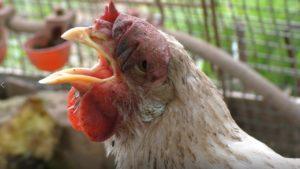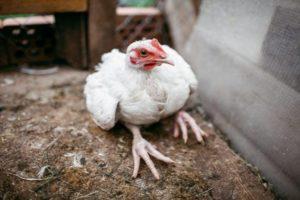Symptoms and causes of mycoplasmosis in domestic chickens, fast and effective treatment
Among the many diseases, mycoplasmosis in domestic chickens is the most common and develops even with a slight violation of their conditions. This pathology is caused by an infection that progresses intracellularly. Mycoplasmosis is considered a rather dangerous disease, which is most often diagnosed in chickens and turkeys.
Definition of disease
Mycoplasmosis is considered an infectious pathology in which the respiratory tract is affected. After the mycoplasma of synovium enters the respiratory system, the reproductive system of birds and muscle tissues are destroyed.
Both adults and young individuals at the embryonic stage are susceptible to mycoplasmosis.
The disease is diagnosed in many breeds, but most often broilers suffer from it due to low immunity.

Causes and ways of infection
The main cause of infection is the appearance of an infected individual in the hen house, secreting bacteria when coughing, sneezing or eating food. Mycoplasma can spread over different distances as birds and hatching eggs move.
Infection of chickens occurs from a diseased swell at the embryonic stage, or after, through the respiratory system when it enters the environment. The risk of developing pathology increases in birds with reduced immunity.
Another common cause of outbreaks in chickens is when temperatures drop too quickly after a hot summer. Even with a mild cold, immunity decreases sharply, and the body becomes susceptible to bacteria. The bird can get sick if it gets into another chicken coop, or after severe stress.
The causative agent of mycoplasmosis is transmitted by airborne droplets, but sometimes through food and water. The infection affects the mucous membranes of the mouth and eyes, and also enters the respiratory system. The peak of the disease is observed in the autumn during damp and cold weather.

Symptoms of the disease
Outbreaks of the disease are noted after contact of chickens with infected individuals. In its development, mycoplasmosis can go through several stages:
- Latent stage. It lasts from 12 to 21 days and is not accompanied by the development of pronounced symptoms. The pathogen spreads throughout the body, penetrating into the blood and muscle tissue.
- Second stage. Birds have a decrease in appetite, they become inactive, lethargic and begin to sneeze.Such symptoms appear only in a small number of infected individuals, while the rest of the disease is asymptomatic.
- Stage Three. When the disease progresses to the next stage, symptoms such as coughing, shortness of breath, increased salivation and foam from the beak appear. In addition, the sick bird refuses food. Additional signs of mycoplasmosis are red staining of the area around the eyes, swelling of the eyelids and wheezing. The characteristic symptom of the disease is a disorder of the stool with the discharge of liquid droppings, colored yellow or green.
- Stage four. At the final stage, the severity of symptoms is dulled, and the infected bird serves as a spread of infection.
Symptoms are exacerbated by sudden changes in temperature, during periods of cold and dampness.

How to diagnose mycoplasmosis in chickens
It is quite difficult to identify the pathology, since it often proceeds in a latent form, and the domestic chicken becomes a carrier of mycoplasmosis. In farms, a method such as a serum-drop agglutination reaction is used to diagnose an ailment. The procedure allows you to quickly determine the level of infection among birds.
It is possible to identify pathology using a method such as a smear using a Petri dish filled with agar. It is possible to assess the genetic predisposition of chickens before infection due to the analysis of the polymer chain reaction.
How to quickly and effectively cure a disease
The veterinarian selects the treatment regimen for the disease after identifying the pathogen. The infected bird is isolated from the chicken coop, because without quarantine, the therapy will not bring any result.

Antibacterial treatment
In small farms, individual treatment is carried out, which includes intramuscular administration of the antibiotic Tylosin. Injections are given during the week 1 time per day.
In large farms, the medication is added to water or feed. The duration of treatment is determined by the number of sick chickens and the degree of their infection with the infection.
For birds, a complex drug such as Furacycline-M can be prescribed. Its constituent components are Tylosin and vitamin B. To eliminate the disease, antibiotics such as Aureomycin, Streptomycin and Oxytetracycline are selected.
Folk remedies
Alternative medicine recipes are allowed to be used as adjunctive therapy to enhance immunity. It is possible to achieve a positive effect with the help of herbal preparations based on:
- St. John's wort and black elderberry root;
- St. John's wort, chamomile, cornflower and corn silk.
In addition, it is recommended to solder the birds with glucose solution and goat milk.

Consequences and prevention
Mycoplasmosis has a negative impact on the overall health and well-being of the chicken. In the absence of effective therapy, both egg and meat productivity of birds decreases. This is due to the fact that they refuse to eat, drink and their mobility is reduced.
With a massive disease, a large number of embryos die and infertility increases.
In addition, it is important to control the normal microclimate in the room where the chickens are kept. To exclude the latent carriage of pathology, an additional examination of embryos that died on the first day of incubation should be carried out.

Is it dangerous for humans
The virus does not pose a danger to the human body, but it is not recommended to eat the meat of an infected individual, and especially at the last stage. The eggs of sick chickens are not used to breed new offspring.
Mycoplasmosis is dangerous for humans because pathologies such as trichomoniasis, staphylococcus and others progress against it. With the penetration of such viruses into the body, there is a high risk of developing an inflammatory process in humans.









